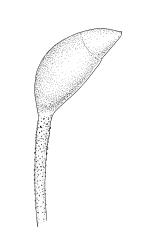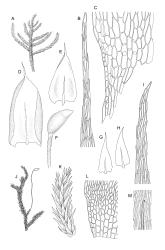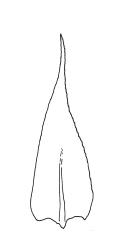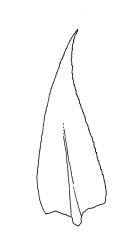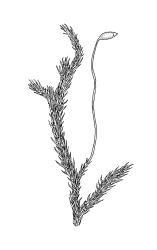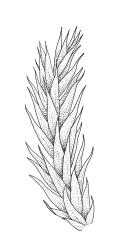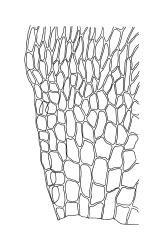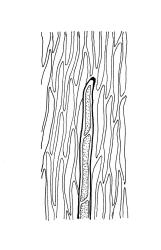Plants medium-sized, yellow-, brown-, or bright green, forming adherent mats on streamside rocks. Stems prostrate, irregularly branched, green, to 30(–45) mm long, in cross-section with a distinct central strand and several layers of thick-walled cortical cells, with scattered tufts of yellow-brown, smooth rhizoids. Branches 5–15(–22) mm long. Stem and branch leaves not differentiated, crowded, homomallous or erect-spreading, symmetric, scarcely altered and smooth or weakly striolate when dry, ovate-lanceolate, acuminate, plane at margins, concave, not or scarcely decurrent, serrulate above or nearly to base, 1.5–2.0 × 0.6–0.8 mm. Costa c. 30–40 µm wide near base, to c. ⅔ the leaf length, usually projecting terminally as an inconspicuous abaxial spine. Upper laminal cells smooth, firm-walled, vermicular, (50–)60–75(–85) µm long, becoming longer in lower leaf; basal cells shorter and ± porose; alar cells subquadrate or short oblong, thick-walled, forming a moderately differentiated group that extends c. 8–12 cells up the margin and c. ½ to the costa base in stem leaves (usually smaller in branch leaves).
Autoicous. Perichaetia lateral on main stems; perichaetial leaves acuminate from an oblong base, ecostate, widely spreading to squarrose. Perigonia gemmiform, c. 1.5 mm long, scattered on main stems, with ecostate, oblong-acuminate bracts and filiform (c. 7-celled) paraphyses. Setae 10–18 mm, scabrose above and smooth below, or rarely smooth throughout, c. 210 µm diam., weakly sinistrorse, yellow-brown; capsules inclined to horizontal, asymmetric, oblong-ovoid, 1.5–2 mm long (excluding operculum), yellow- to dark brown; exothecial cells irregular in shape and size. Annulus weakly differentiated, of 2–3 cell rows; operculum conic, acute or shortly rostrate at apex. Exostome teeth lanceolate; endostome with cilia well-developed, in groups of 1–3, and appendiculate. Calyptra c. 2 mm long. Spores c. 12–18 µm, nearly smooth.
Crum & Anderson 1981, fig. 506; Beever et al. 1992, fig. 78 h; Hedenäs 2002, fig. 2 j–k; Smith 2004, fig. 278, 11–15.
The combination of smooth or only weakly striolate leaves, branch leaves scarcely differentiated in shape from stem leaves, lack of twisted leaf apices, setae that are scabrose above and smooth below, and a strong preference for non-calcareous rocks near moving water generally make this species easily recognisable. This habitat is similar to that of Sematophyllum jolliffii, but the ovate-lanceolate and acuminate leaves of B. plumosum serve to distinguish it from that species. Sematophyllum jolliffii has elliptic and broadly acute leaves. Coloration helps distinguish them in the field, and S. jolliffii has cuspidate and moderately flattened branch apices; both species have variably scabrose setae. There is no other species with which B. plumosum is likely to be confused.
NI: N Auckland, S Auckland, Gisborne, Hawke’s Bay (Kaweka Range) Wellington; SI: Nelson, Marlborough, Canterbury, Westland, Otago, Southland, A.
Nearly cosmopolitan.
On non-calcareous rocks in stream beds, less commonly at lake margins, occasionally away from moving water, and sometimes on sandy soil, tree bases, logs, or rock faces. Occasionally occurring as an epiphyte in humid subalpine areas. Ranging from near sea level to at least 1280 m (Kaweka Range, Hawke’s Bay L.D.) on the North I. and from near sea level (Pelorus Bridge Scenic Reserve, Marlborough L.D.) to at least 1600 m (St Arnaud Range, Nelson L.D.) on the South I.



